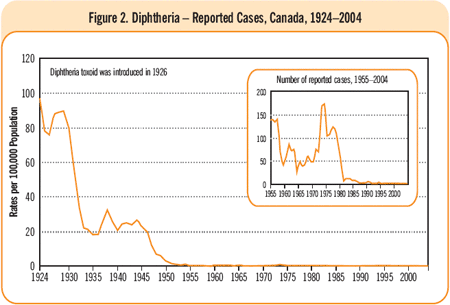Common menu bar links
Institutional links
Diseases & Conditions
Health & Safety
Research & Statistics
Agency Information
Search Box
E-mail this page
Vaccine-Preventable Diseases
Diphtheria
Diphtheria is an acute, communicable disease caused by exotoxin-producing strains of the bacterium Corynebacterium diphtheriae. Symptoms result from local infection of the respiratory tract, which may lead to breathing difficulties, or infection of the skin or mucosal surfaces, or from dissemination of diphtheria toxin, which damages the heart and central nervous system. The case-fatality rate remains at about 5% to 10%, the highest death rates occurring among the very young and the elderly. About 3%-5% of healthy persons may be asymptomatically colonized on the skin or in the nasopharynx with C. diphtheriae, making eradication of the disease difficult.
Epidemiology
Routine immunization against diphtheria in infancy and childhood has been widely practised in Canada since 1930. In 1924, there were 9,000 cases reported, the highest annual number ever recorded in Canada (see Figure 2). At the same time diphtheria was one of the most common causes of death in children from 1 to 5 years of age. By the mid-1950s, routine immunization had resulted in a remarkable decline in the morbidity and mortality of the disease. Toxigenic strains of diphtheria bacilli are detected each year, although classic diphtheria is rare. In Canada, there are 0 to 5 isolates reported each year. In developed countries occasional cases of imported diphtheria are identified.
Serosurveys of healthy adult populations in Canada indicate that approximately 20% of those surveyed (higher in some age groups) do not have protective levels of antibody to diphtheria. The potential for disease reemergence if immunization levels are allowed to fall was demonstrated during the 1990s in the Commonwealth of Independent States (former Soviet Union), where over 140,000 cases and 4,000 deaths were reported.
Source: Canadian Immunization Guide, 7th edition, 2006
Links to more information
Guidelines and Recommendations
- For information about Diphtheria vaccine, see the Canadian Immunization Guide, 7th edition 2006
- Guidelines on Control of Diphtheria in Canada
Information Sheets
Travel Medicine Program

